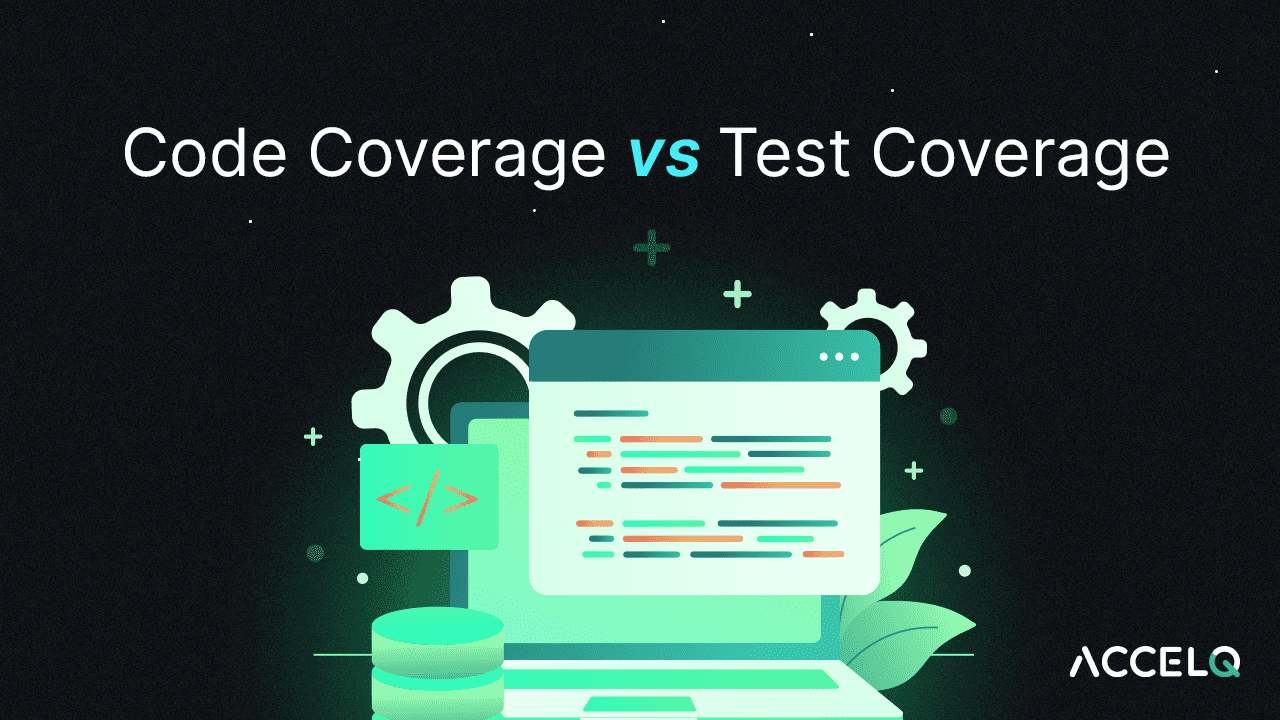Code Coverage vs Test Coverage: What’s the Real Difference?

When software teams strive for high quality and faster releases, they frequently face two vital metrics: code coverage and test coverage. Although these terms can be interchangeable, they have different roles and provide distinct views on the efficiency of a test suite. They both play an important role in determining how well software is being tested, but they tackle the problem differently.
While code coverage cares about which lines of the source code were run, test coverage zooms out and asks how much of the functionality, or requirements, is covered. In combination, these three measures represent a comprehensive level of testing effectiveness.
This guide dives deep into what each metric means, how they differ, and how teams can maximize both using intelligent automation.
- Understanding the Basics of Code Coverage vs Test Coverage
- Code Coverage vs Test Coverage: Key Differences
- Code Coverage vs Unit Test Coverage
- Why Test and Code Coverage Matter?
- Common Types of Code Coverage Metrics
- Measuring and Improving Test Coverage
- How ACCELQ Helps You Maximize Both?
- Similarities Between Code Coverage and Test Coverage
- Real-World Example
- Best Practices to Balance the Two
- Conclusion
Understanding the Basics of Code Coverage vs Test Coverage
What is Code Coverage?
Code coverage is a white-box testing metric that measures the percentage of code executed during testing. It focuses on verifying internal structures such as functions, branches, statements, and paths within the source code.
What is Test Coverage?
Test coverage is a black-box testing metric that evaluates the extent to which the software’s requirements and functionalities are exercised by a test suite. It reflects the quality of the tests from an external behavior standpoint.
Code Coverage vs Test Coverage: Key Differences
Code coverage and test coverage are often confused but serve fundamentally different roles in software testing. Understanding the distinction between them is essential for teams aiming to deliver robust, high-quality applications. While code coverage helps ensure internal code logic is exercised, test coverage ensures external behaviors and requirements are adequately validated.
| Attribute | Code Coverage | Test Coverage |
|---|---|---|
| Definition | Measures code executed during testing | Measures how well tests cover functional requirements |
| Metric Type | Quantitative (expressed in percentages) | Qualitative (coverage of features, not always numerical) |
| Testing Approach | White-box testing | Black-box testing |
| Focus Area | Internal code logic | External system behavior |
| Testing Stage | Typically used in unit testing | Applied during integration, system, or acceptance testing |
| Visibility | Helps identify untested parts of code | Reveals gaps in feature or requirement testing |
| Knowledge Required | Requires deep understanding of code | Can be implemented without knowing internal code |
| Measurement Tool | Code instrumentation tools (e.g., JaCoCo, Istanbul) | Requirement traceability tools |
Code Coverage vs Unit Test Coverage
Though code coverage and unit test coverage are related, they are not interchangeable. Code coverage measures how much of the codebase is exercised across all levels of testing, while unit test coverage focuses solely on the extent to which individual units or components are tested.
Although code coverage is commonly associated with unit tests, they are not the same. Here’s how code coverage vs unit test coverage differ:
| Attribute | Code Coverage | Unit Test Coverage |
|---|---|---|
| Scope | Measures execution of code | Measures how much of the code is tested via unit tests |
| Use Case | Applied to unit, integration, and functional tests | Limited to unit tests |
| Tools Used | JaCoCo, Cobertura, etc. | JUnit, NUnit, TestNG, etc. |
Why Test and Code Coverage Matter?
Both test coverage vs code coverage are key indicators of software quality. They provide different yet complementary perspectives—code coverage assures internal logic validation, while test coverage guarantees feature completeness and alignment with business requirements. Together, they minimize risk and improve the reliability of software systems.
Both metrics aim to enhance software quality but address different aspects:
Benefits of Code Coverage:
- Identifies unused or dead code
- Ensures all conditions and branches are validated
- Improves maintainability of codebase
Benefits of Test Coverage:
- Verifies alignment with business requirements
- Provides insight into feature-level completeness
- Aids in risk-based testing prioritization
By combining both, teams can identify blind spots in code and functionality alike.
Common Types of Code Coverage Metrics
Understanding the specific areas you can cover at the code level helps maximize effectiveness. Here are key metrics:
- Statement Coverage: Verifies whether every statement in the code has been executed.
- Branch Coverage: Checks whether each possible branch (e.g., if-else conditions) is tested.
- Function Coverage: Validates whether each function or method is called during the test cycle.
- Path Coverage: Ensures that every possible execution path through a function is tested.
Measuring and Improving Test Coverage
Test coverage can be improved through:
- Requirement Traceability Matrices (RTM)
- Test case design techniques like boundary value analysis and equivalence partitioning
- Exploratory testing for unstructured validation
How ACCELQ Helps You Maximize Both?
ACCELQ is an AI-powered, codeless test automation platform that bridges the gap between code and test coverage through:
1. End-to-End Automation
ACCELQ enables white-box and black-box testing within one platform. Whether it’s unit tests or complex workflows, all can be automated with minimal effort.
2. Real-Time Coverage Insights
Get actionable data on test execution and code impact, helping you assess both the quantitative (code) and qualitative (test) coverage.
3. Business Process-Focused Testing
Unlike traditional tools that operate at a technical level, ACCELQ focuses on business workflows. This helps ensure that critical end-user scenarios are always covered.
4. Codeless Test Creation
With ACCELQ, testers without coding experience can build and execute test cases that fulfill coverage goals without technical bottlenecks.
Similarities Between Code Coverage and Test Coverage
While the approaches differ, there are notable overlaps:
- Both aim to ensure software quality by reducing risk and catching bugs early.
- Both rely on test automation to streamline and scale efforts.
- Both benefit from detailed reporting and traceability.
Real-World Example
Imagine a flight booking platform. Code coverage might measure how much of the internal pricing logic is tested, while test coverage ensures features like seat selection and payment gateway are covered.
Together, they help ensure:
- The application doesn’t break during deployment
- All user scenarios are validated end-to-end
- Business logic and codebase remain clean and efficient
Best Practices to Balance the Two
- Don’t chase 100% code coverage — diminishing returns set in quickly.
- Use test coverage to inform business risk areas.
- Incorporate coverage reports into CI/CD pipelines for real-time quality control.
- Combine unit, integration, and system testing to cover all angles.
- Leverage intelligent platforms like ACCELQ for unified visibility.
Conclusion
Code coverage and test coverage are both important metrics, but they answer different questions. Code coverage informs you about the proportion of your code that is run, whereas test coverage describes the proportion of your system’s tested functionality.
In order to deliver quality applications, teams must not treat the apps as their own little isolated silos. Instead, leverage solutions such as ACCELQ that streamline and automate the whole process, increasing trust in the release, reducing defects, and time to market.
Looking to strengthen your testing strategy with holistic coverage insights? Get started with ACCELQ today and elevate your automation game.
Prashanth Punnam
Sr. Technical Content Writer
With over 8 years of experience transforming complex technical concepts into engaging and accessible content. Skilled in creating high-impact articles, user manuals, whitepapers, and case studies, he builds brand authority and captivates diverse audiences while ensuring technical accuracy and clarity.
You Might Also Like:
 Top Software Testing Conferences you must attend in 2025
Top Software Testing Conferences you must attend in 2025
Top Software Testing Conferences you must attend in 2025
 Supercharge Testing with AI: Automate & Accelerate Efficiency
Supercharge Testing with AI: Automate & Accelerate Efficiency
Supercharge Testing with AI: Automate & Accelerate Efficiency
 BDD in Testing: Improve Automation & Team Productivity
BDD in Testing: Improve Automation & Team Productivity
































